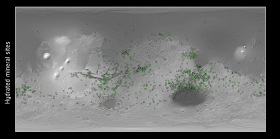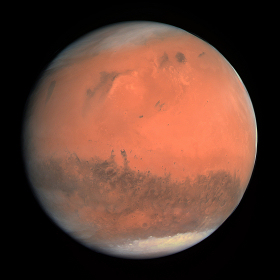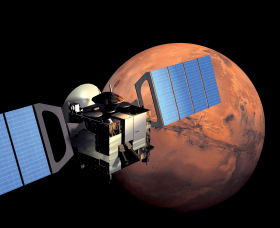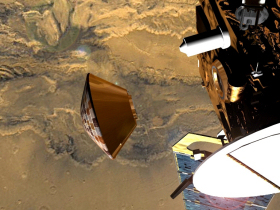Summary
Europe waited a long time for the opportunity to mount its own mission to Mars and that dream became a reality with the launch in 2003 of Mars Express. ESA's mission to the Red Planet marked the opening of a new era for Europe in planetary exploration. This ESA project was also the start of an innovative way of organising the building blocks that form European space missions. The spacecraft was built and launched in record time and at a much lower cost than previous, similar missions into outer space.
A scientific water diviner
Mars Express was the first 'flexible' mission of ESA's long-term science exploration programme. The journey to the Red Planet began on 2 June 2003 with the launch from the Baikonur Cosmodrome on a Soyuz-Fregat rocket. It ended on 25 December 2003 with the successful orbit insertion.
Mars Express comprises a number of essential components - the spacecraft and its instruments, the lander, a network of ground and data processing stations, and the launcher itself. These are supported by an experienced team of engineers in ESA and industry and hundreds of international scientists.
With its complement of seven instruments, Mars Express was designed to study all aspects of the Red Planet, including its atmosphere and climate, and the mineralogy and geology of the surface and subsurface. Since beginning science operations in 2004, the durable orbiter has given scientists an entirely new view of Earth's intriguing neighbour. Read more about the scientific highlights from the mission in this article marking ten years of Mars Express operations.
The lander, called Beagle-2 after the ship in which Charles Darwin set sail to explore unchartered areas of the Earth in 1831, represented an exciting opportunity for Europe to contribute to the search for life on Mars.
While addressing its science objectives, Mars Express also provides relay communication services between the Earth and various landers deployed on the surface by other nations, thus forming a centre piece of the international effort in Mars exploration.
Searching for the elixir of life
Scientists hope that the instruments onboard Mars Express will detect the presence of water below the surface. This could exist in the form of underground rivers, pools, aquifers or permafrost. Overall, the main goals of the instruments to be carried by the Mars Express orbiter are:
- Sharp-eyed, 3D photography to discover more about the surface and geology of Mars.
- Looking at the 'invisible' beneath the surface by using radar beams to penetrate below ground. Different materials or structures will send back different radar echoes allowing scientists to produce an accurate 3D survey.
- Precise determination of atmospheric circulation and composition to build up an accurate picture of Martian meteorology and climate.
- Study of the interaction of the atmosphere with outer space.
 |
| Mars hydrated mineral map. Credits: ESA/CNES/CNRS/IAS/Université Paris-Sud, Orsay; NASA/JPL/JHUAPL; Background image: NASA MOLA |
Gathering such information on the history and present day circumstances of Mars may also improve our understanding of phenomena that influence our own environment. For example, if we can determine why Martian water disappeared in the past we may learn more about whether a similar fate one day awaits the oceans of Earth. The Mars Express spacecraft and its instruments represent a truly international endeavour - a stereoscopic camera from Germany, a mineralogical mapping device from France and an atmospheric sounder from Italy. The radar instrument, to probe for water at depths of a few kilometres below the surface, was built jointly between Italy and the Jet Propulsion Laboratory in California. The Beagle-2 landing craft was designed and built in the UK. As well as the remote observation payload, the orbiter carries a lander communications package to support international Mars lander missions from 2003 to 2007.
The fate of Beagle-2
 |
|
Beagle-2 on Mars. Credit: HIRISE/NASA/Leicester |
Beagle-2 was released from its mother craft on 19 December 2003 and was due to land six days later. Nothing was heard from the lander after its scheduled touchdown, and searches by Mars Express and NASA's Mars Odyssey mission were fruitless.
In January 2015, the UK space agency announced that the lander has been identified in images from NASA's Mars Reconnaissance Orbiter. The images appear to show the lander partially deployed on the surface.
How Europe got to Mars
The selection of a Soyuz/Fregat launcher to put Mars Express on its course towards Mars was linked to the flexible approach adopted by ESA. The launcher was procured through Starsem, a Russian/European company. As a relatively low-cost launcher it helped keep the overall cost of the Mars Express mission within a total initial budget of 150 million Euros.



